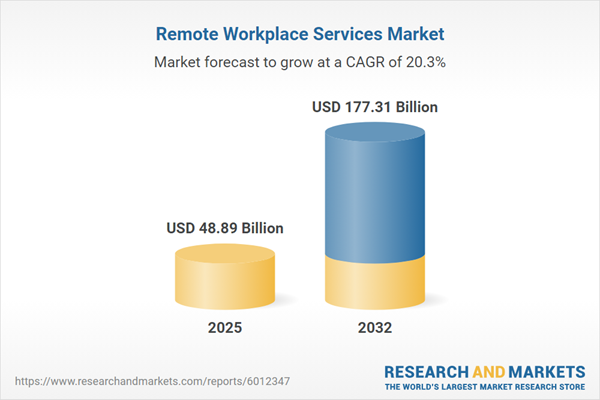Speak directly to the analyst to clarify any post sales queries you may have.
The remote workplace services market is revolutionizing how organizations support hybrid and distributed teams by providing secure, flexible, and collaborative solutions. Senior decision-makers are increasingly seeking robust digital workplace strategies that foster resilience, enable seamless collaboration, and uphold business continuity standards.
Market Snapshot: Remote Workplace Services Market
Accelerated digital transformation initiatives are fueling substantial growth in the remote workplace services market, marked by heightened investments and a notable compound annual growth rate. Enterprises continue modernizing digital infrastructures, prioritizing scalable cloud technologies and agile workplace tools to enhance team productivity and support evolving work models. Market trends reveal a growing preference for flexible workplace arrangements, streamlined collaboration across distributed teams, and smooth transitions between remote and hybrid work. Enterprise leaders are increasingly adopting unified communications and integrated workflow software to ensure uninterrupted, device-independent access for global workforces. Advanced IT support and security measures have become standard, enabling consistent connectivity and operational efficiency for geographically dispersed teams.
Scope & Segmentation: Navigating the Remote Workplace Services Market Landscape
This report delivers actionable segmentation and in-depth analysis to help senior leaders drive operational resilience and pinpoint opportunities within the digital workspace. Each segment underscores strategic priorities and shapes organizational adaptability:
- Service Type: Includes cloud-based infrastructure, collaboration platforms, video conferencing, unified communications, VoIP, managed network services, virtual whiteboards, consulting, deployment services, and cybersecurity. Each service addresses the diverse needs of evolving security, productivity, and digital connectivity.
- Deployment Model: Offers public, private, community, hybrid, and full on-premise solutions, ensuring enterprises can meet unique compliance and technical requirements while adapting to shifting workloads.
- Organization Size: Solutions are tailored to large enterprises, midsize firms, and small businesses, ensuring scalable adoption and compliance across all segments.
- Industry Vertical: Covers sectors such as banking, insurance, pharmaceuticals, education, healthcare, medical devices, retail, and public sector, supporting workflow customization and hybrid or digital-first initiatives.
- Organization Type: Flexible platforms support both public and private sector operations, adapting features to sector-specific compliance and business objectives.
- Geographic Region: Analysis spans the Americas, Europe, Middle East and Africa, and Asia-Pacific, focusing on local regulatory frameworks, digital maturity, and infrastructure development. Leading technology markets such as the United States, China, Germany, and India influence adoption patterns and benchmark standards.
- Notable Vendors: Major providers—Microsoft, Zoom Video Communications, Cisco Systems, Alphabet Inc., Amazon.com, Salesforce, RingCentral, 8x8, Avaya Holdings, and Citrix Systems—deliver advanced capabilities that support both remote and hybrid workforce requirements.
Key Takeaways for Senior Decision-Makers
- Integrated workplace technologies are critical for fostering secure communication, collaboration, and business continuity across distributed and hybrid working environments.
- Managed services optimize digital workspace deployment and help ensure compliance with cross-border and sector-specific regulatory requirements as organizations expand internationally.
- Vendor selection and continuous solution assessment are vital for operational stability, enabling enterprises to align technology infrastructure with evolving business needs.
- Diverse deployment models allow organizations to balance technical, regulatory, and strategic needs, particularly in situations where full cloud adoption is not optimal.
- Regional dynamics strongly impact adoption strategies—advanced infrastructure in North America and Asia-Pacific facilitates higher uptake, while distinct regulatory and readiness challenges in Europe, Middle East, and Africa require region-specific rollout approaches.
- Partnering with independent software vendors and systems integrators streamlines transformation, driving efficiency and smoother integration of new digital solutions.
Tariff Impact: Economics of Remote Service Delivery
Recent changes in United States tariffs are driving increased costs for key technology hardware, cloud-based services, and endpoint devices. Enterprises are mitigating these impacts by diversifying supply chains, adopting subscription-based purchasing, and sourcing critical assets domestically or regionally. Regional data centers and hybrid cloud deployments are also being expanded to support compliance and minimize risk from tariff fluctuations. These strategies help safeguard business operations and enable continued transformation amid evolving global trade dynamics. Procurement processes are adapting to bolster supply chain resilience and limit exposure to future economic disruptions.
Methodology & Data Sources
This report combines direct interviews with enterprise executives, technology architects, and procurement specialists, validated by thorough regulatory and financial documentation reviews. This comprehensive approach ensures dependable insights for shaping remote workplace strategies and investments.
Why This Report Matters
- Equips senior leaders with the information needed to navigate operational, compliance, and technology challenges specific to remote workforce management.
- Clarifies the structure and segmentation of the remote workplace services market, supporting strategic transformation across varied regions and industries.
- Supports proactive vendor assessment, risk mitigation, and supply chain strategy for improved agility and sustainability in a changing regulatory landscape.
Conclusion
This report delivers practical insights and strategic guidance to help organizations develop adaptive, resilient remote workplace environments that align with business objectives and sustain enterprise transformation at scale.
Additional Product Information:
- Purchase of this report includes 1 year online access with quarterly updates.
- This report can be updated on request. Please contact our Customer Experience team using the Ask a Question widget on our website.
Table of Contents
3. Executive Summary
4. Market Overview
7. Cumulative Impact of Artificial Intelligence 2025
Companies Mentioned
The companies profiled in this Remote Workplace Services market report include:- Microsoft Corporation
- Zoom Video Communications, Inc.
- Cisco Systems, Inc.
- Alphabet Inc.
- Amazon.com, Inc.
- Salesforce, Inc.
- RingCentral, Inc.
- 8x8, Inc.
- Avaya Holdings Corp.
- Citrix Systems, Inc.
Table Information
| Report Attribute | Details |
|---|---|
| No. of Pages | 185 |
| Published | October 2025 |
| Forecast Period | 2025 - 2032 |
| Estimated Market Value ( USD | $ 48.89 Billion |
| Forecasted Market Value ( USD | $ 177.31 Billion |
| Compound Annual Growth Rate | 20.2% |
| Regions Covered | Global |
| No. of Companies Mentioned | 11 |









